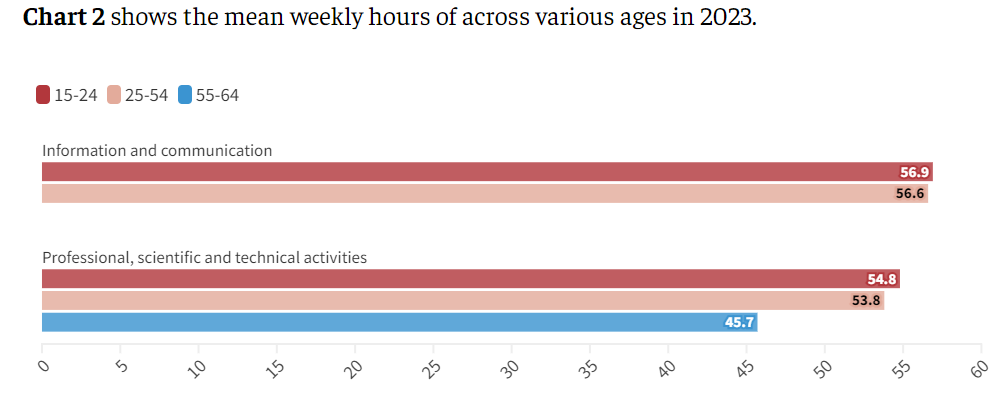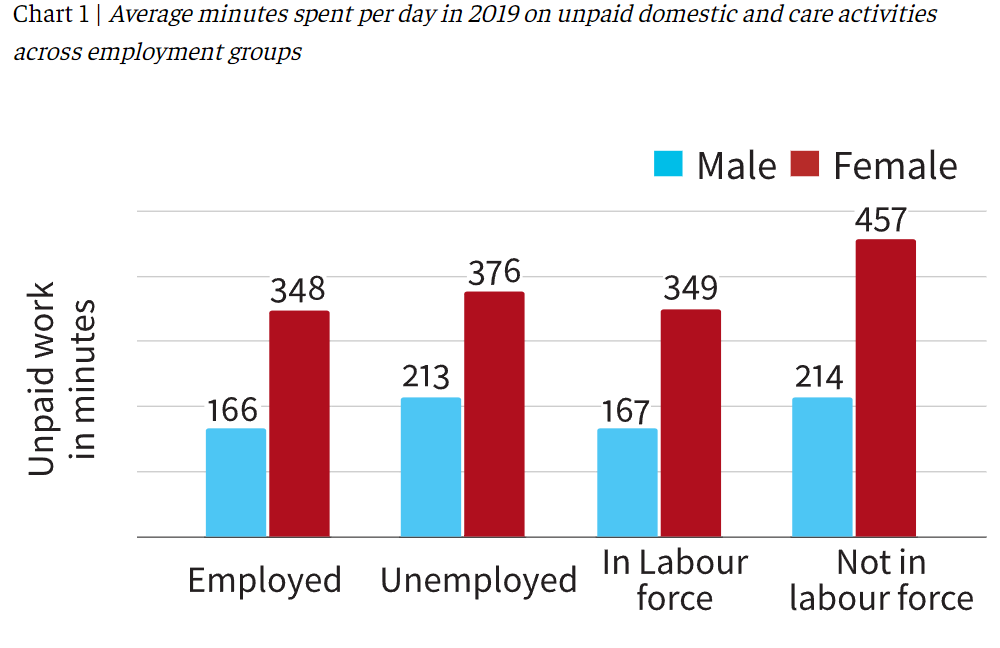Disproportionate Burden on Working Women | 27 Sep 2024
For Prelims: Women's Labor Force Participation, Wage Disparities, Gender Disparity, Female Labor Force Participation Rate, International Labour Organization (ILO)
For Mains: State of Women Participation in Workforce, Corporate, Challenges and Barrier to Women's Labor Force Participation.
Why in News?
The recent tragic death of a 26-year-old female Chartered Accountant at Ernst & Young (EY), has reignited discussions about the excessive workload and stress faced by young women professionals (white- collars) in India.
What is the State of Working Women in India?
- Work Hours and Stress Levels:
- According to the International Labour Organisation (ILO) report, young professional Indian women work an average of 55 hours per week, with 9-11 hours daily, leaving only 7-10 hours for rest due to household responsibilities.
- Compared globally, in Germany women in IT and media work for 32 hours, and in Russia, for 40 hours.
- According to the International Labour Organisation (ILO) report, young professional Indian women work an average of 55 hours per week, with 9-11 hours daily, leaving only 7-10 hours for rest due to household responsibilities.
- The Younger Professional Women Work More:
- Women aged 15-24 in ICT/media roles worked approximately 57 hours weekly, while those in professional, scientific and technical activities logged about 55 hours.
- This data suggests that as age decreases, the number of hours worked increases, highlighting a concerning trend for younger women entering the workforce.
- Women aged 15-24 in ICT/media roles worked approximately 57 hours weekly, while those in professional, scientific and technical activities logged about 55 hours.
- Gender Imbalance in Professional Roles:
- Only 8.5% of women hold professional scientific and technical jobs, and 20% are in ICT sectors.
- India ranks 15th lowest among 145 countries in women's representation in professional scientific and technical roles.
- Only 8.5% of women hold professional scientific and technical jobs, and 20% are in ICT sectors.
- Women Leading in Unpaid Domestic Work:
- As per National Family Health Survey (2019-21) data, in 2019, women not in the labour force spent 7.5 hours daily on unpaid domestic and care work.
- Employed women spent an average of 5.8 hours daily on unpaid domestic work.
- Unemployed men contributed 3.5 hours, while employed men spent only 2.7 hours daily on domestic work.
- Regional Variations:
- About 85% of women aged 15-59 do unpaid domestic work, showing little difference between urban and rural areas.
- Male participation is below 50% in many areas, in states like Haryana and Rajasthan as per NFHS (2019-21) data.
What is the Scenario for the White-Collar Jobs in India?
- Current Situation of Regulation:
- White-Collar Worker refers to a salaried professional, typically performing administrative or managerial tasks.
- Currently, several central legislations, such as the Industrial Disputes Act, 1947, the Shops and Establishments Act, 1954, and the Factories Act, 1948, govern the rights of private employees.
- The lack of standard contract templates leads to differences between companies, causing inconsistencies in employee rights and complicating regulations.
- Need for Regulation:
- A 2023 ASSOCHAM study found that 42% of Indian white-collar workers exceed the legal limit of 48 working hours per week.
- Additionally, a 2022 TeamLease survey (India-based HR company) revealed that 68% of professionals struggle with work-life balance, affecting their mental health and personal relationships.
- The rise of the gig economy further complicates matters, as many freelancers lack access to essential benefits like paid leave and health insurance.
- Concerns Against Stricter Labour Laws:
- Impact on Innovation and Adaptability: Stricter regulations may hinder the flexibility and rapid response essential for dynamic sectors like IT.
- Employer-Employee Relationships: Open communication and mutual trust are considered more effective for achieving work-life balance than rigid regulations.
- Effect on Job Creation: Increased compliance costs could lead to reduced hiring or layoffs, negatively affecting the employment landscape.
What are the Challenges to Women's Participation in the Labor Force?
- Patriarchal Social Norms: Deep-rooted patriarchal norms and traditional gender roles restrict women's access to education and employment. Societal expectations often prioritise their roles as caregivers and homemakers, discouraging active participation in the workforce.
- Gender Wage Gap: Women in India face significant wage disparities compared to men. According to the World Inequality Report 2022, men earn 82% of labour income, while women capture only 18%. This wage gap discourages women from pursuing formal employment.
- Safety Concern: Women often face safety concerns in the workplace, including harassment and violence, which deter their participation in the labour force.
- Underrepresentation in Leadership Roles: Women are often underrepresented in leadership and decision-making positions which perpetuate gender biases in organisational policies and hinder the advancement of other women in the workforce.
What Can be Done to Improve Working Conditions for Women in White-Collar Roles?
- Focus on Women’s Inclusion and Support: Policies ensuring gender equality, including paid maternity leave, flexible hours, and safe workplace environments, are essential to improving conditions for women in white-collar jobs.
- Companies should work to eliminate gender bias in hiring, promotion, and pay to foster equal opportunities.
- Cultural Transformation: Promoting employee well-being through CSR initiatives like arrangements for women’s mental health support, and discouraging excessive work hours can enhance work-life balance and reduce burnout.
- Legal Reforms and Enforcement: Strict enforcement of existing labour laws is crucial, along with updating regulations to address gig and freelance work. This includes ensuring minimum wage, addressing safety concern of women, social security benefits, and efficient dispute resolution mechanisms for non-traditional workers.
- Government Policies and Awareness: Governments should create policies that encourage flexible work environments, ensure health coverage, and promote diversity.
- Awareness campaigns on employee(including women) rights and employer responsibilities can also help in maintaining fair working conditions.
|
Drishti Mains Question: What are the challenges faced by women in the workforce in India, and what measures can be implemented to address these issues? |
UPSC Civil Services Examination, Previous Year Question (PYQ)
Prelims
Q. Which of the following gives ‘Global Gender Gap Index’ ranking to the countries of the world? (2017)
(a) World Economic Forum
(b) UN Human Rights Council
(c) UN Women
(d) World Health Organization
Ans: (a)
Mains
Q. ‘’Empowering women is the key to control the population growth.’’ Discuss. (2019)



